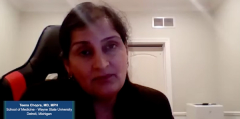
Strains of C. Difficile
Episodes in this series

What health care providers need to know about the 2 strains of C. difficile, including types of patients impacted and typical outcomes.
Peter L. Salgo, MD: So, there is C diff [Clostridioides difficile] and then there is C diff. Does it matter clinically if you make that distinction if the patient has diarrheal illness? Dale, does it matter?
Dale N. Gerding, MD: It sure does. The strains have been epidemic since the turn of the 21st century. The so-called 027 strain and the 07A strain have higher mortality associated with them. By the way, this is not a benign diarrhea. Patients are usually older. Many of them don’t tolerate it, and the mortality can easily exceed 5% So these strains of toxin are very lethal, especially in older patients.
Peter L. Salgo, MD: I want to stop you because that is a shocking number: 5%. That is an enormous mortality figure. Is it because the bacterium—or whatever you want to call it; I guess it’s a bacterium—is a bad bacterium or because the population that it affects is so susceptible and immunocompromised? [The patients are] often old, often debilitated. What do you think?
Dale N. Gerding, MD: It’s a combination of both. There are lots of papers out there that say there is and there isn’t a difference in the mortality of the 027 strain. Most of them think there is a difference, and it’s a higher mortality. But this strain is also associated with infecting older people much more commonly than younger people. You can’t get away from the fact that the older people are more susceptible and are likely to be immunocompromised and likely to have higher mortality.
Peter L. Salgo, MD: Yeah, people are fond of saying that 70 is the new 40, but not necessarily the [patients with] C diff.
Dale N. Gerding, MD: Often people in their 80s and 90s have the highest mortality.
Thomas Lodise, PharmD, PhD: We see that a lot at the VA [Edward Hines Jr Veterans Affairs Hospital] too. I think Dale can attest to this when we think about some of the statistics with C diff. Once you get past 65 years old, you see a substantial increase in mortality and estimate at 1 of 10. You see this linear curve, but that goes up with age, particularly individuals who get the epidemic strain.
Peter L. Salgo, MD: Come back to that number again. These numbers—I knew them, but I’m hearing them again, and they’re scaring me. Over 65 the mortality is 10%, 1 of 10?
Paul Feuerstadt, MD, FACG, AGAF: Yes, 1 of 10 will die.
Peter L. Salgo, MD: That is higher than what we’re seeing with COVID-19 [coronavirus disease 2019] right now. Yet nobody is speaking about this the way we’re speaking. I understand why, but this is a disease that is killing people.
Teena Chopra, MD, MPH: That’s why it’s labeled as an urgent threat by the CDC [Centers for Disease Control and Prevention], because of the high mortality and morbidity. One important thing we should also remember is the changing epidemiology. We are seeing over the years that the hospital-acquired C diff has sort of plateaued. But the community-onset C diff is on the right because of the poor antibiotics we have in our community. We have good stewardship programs in the hospital, but we don’t have as strong stewardship programs in the community. Community on set C diff is on the rise.
Peter L. Salgo, MD: If you enjoyed this content, you should subscribe. We have an e-newsletter, and you can receive upcoming Peer Exchanges and other great content in your in-box—that’s right, electronically. I’ll see you next time. I’m Dr Peter Salgo. Thanks again for watching.
Newsletter
Stay informed on drug updates, treatment guidelines, and pharmacy practice trends—subscribe to Pharmacy Times for weekly clinical insights.






























































































































































































































